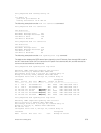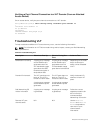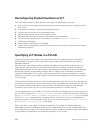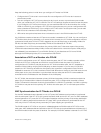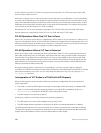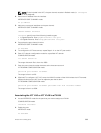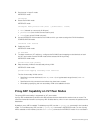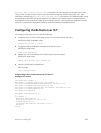and the VLAN is a primary VLT VLAN on one peer and not a primary VLT VLAN on the other peer, MAC
synchronization does not occur.
Whenever a change occurs in the VLAN mode of one of the peers, this modification is synchronized with
the other peers. Depending on the validation mechanism that is initiated for MAC synchronization of VLT
peers, MAC addresses learned on a particular VLAN are either synchronized with the other peers, or MAC
addresses synchronized from the other peers on the same VLAN are deleted. This method of processing
occurs when the PVLAN mode of VLT LAGs is modified.
Because the VLTi link is only a member of symmetric VLT PVLANs, MAC synchronization takes place
directly based on the membership of the VLTi link in a VLAN and the VLT LAG mode.
PVLAN Operations When One VLT Peer is Down
When a VLT port moves to the Admin or Operationally Down state on only one of the VLT nodes, the VLT
Lag is still considered to be up. All the PVLAN MAC entries that correspond to the operationally down VLT
LAG are maintained as synchronized entries in the device. These MAC entries are removed when the peer
VLT LAG also becomes inactive or a change in PVLAN configuration occurs.
PVLAN Operations When a VLT Peer is Restarted
When the VLT peer node is rebooted, the VLAN membership of the VLTi link is preserved and when the
peer node comes back online, a verification is performed with the newly received PVLAN configuration
from the peer. If any differences are identified, the VLTi link is either added or removed from the VLAN.
When the peer node restarts and returns online, all the PVLAN configurations are exchanged across the
peers. Based on the information received from the peer, a bulk synchronization of MAC addresses that
belong to spanned PVLANs is performed.
During the booting phase or when the ICL link attempts to come up, a system logging message is
recorded if VLT PVLAN mismatches, PVLAN mode mismatches, PVLAN association mismatches, or PVLAN
port mode mismatches occur. Also, you can view these discrepancies if any occur by using the show
vlt mismatch command.
Interoperation of VLT Nodes in a PVLAN with ARP Requests
When an ARP request is received, and the following conditions are applicable, the IP stack performs
certain operations.
• The VLAN on which the ARP request is received is a secondary VLAN (community or isolated VLAN).
• Layer 3 communication between secondary VLANs in a private VLAN is enabled by using the ip
local-proxy-arp
command in INTERFACE VLAN configuration mode.
• The ARP request is not received on the ICL
Under such conditions, the IP stack performs the following operations:
• The ARP reply is sent with the MAC address of the primary VLAN.
• The ARP request packet originates on the primary VLAN for the intended destination IP address.
The ARP request received on ICLs are not proxied, even if they are received with a secondary VLAN tag.
This behavior change occurs because the node from which the ARP request was forwarded would have
replied with its MAC address, and the current node discards the ARP request.
986
Virtual Link Trunking (VLT)




